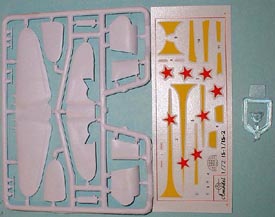Amodel’s 1/72 IS-1 By Matt Bittner |  | History During the late 1930's Soviet Designer Vasili Nitkin sought to bridge the gap between the superior low-speed handling characteristics and maneuverability of the biplane layout with the higher performance of monoplane deigns. His resulting IS fighter prototype of 1940 ('istrebitel' skladnoy, or folding fighter) was an innovation unknown outside the USSR, and one of the most remarkable designs of the era. The lower wings were hinged to the bottom of either fuselage side, and carried the landing gear members. Upon retraction, the entire wing and gear combination would fold up to lie flush within both the fuselage side (gear) and into recesses in the upper wing undersurface (wing). The retraction mechanism was flawless in operation, and so outstanding that in fact the aircraft could be flown with the lower wing/gear left in any partially retracted state. Power was provided by the M-63 radial, and the armament comprised four 7.62mm ShKAS in the upper wing's central sections. The second IS prototype featured revised streamlining and a more powerful M-88 radial engine. Even so, the maximum speed did not exceed 310 mph (502 km/h), and no production was attempted.  The Kit The Kit
The Amodel Shevchenko IS-1 consists of 71 injected molded parts in gray and one clear piece used as the windscreen. There are decals for only one scheme, an attractive machine green over blue, but with yellow “sashes” all over the sides of the fuselage. Molding is typical Amodel – nice enough detail, but that detail is molded to the sprue with large gates. Much care will be needed to remove these parts from the sprue, especially the smaller ones. Construction starts with a very nice cockpit. In fact, the cockpit reminds me a lot of the ICM/Encore Polikarpov I-152 in that it has separately molded side frames that attach to the cockpit floor. In addition the cockpit comes with rudder pedals, a control column, seat, backrest and a nicely molded instrument panel. Unfortunately one of my side-frames was damaged in route, but it shouldn’t be a big problem to either fix it, or replace it entirely with round sprue.  After painting the cockpit subassembly and the fuselage interior, construction continues with sandwiching the cockpit with the fuselage halves, adding the firewall and wiring for the engine, along with the addition of the separate fin/rudder and horizontal tailpieces. Unfortunately the rudder is not separate. After painting the cockpit subassembly and the fuselage interior, construction continues with sandwiching the cockpit with the fuselage halves, adding the firewall and wiring for the engine, along with the addition of the separate fin/rudder and horizontal tailpieces. Unfortunately the rudder is not separate.
The next step in construction is the addition of the upper wing, the continuation of the build-up of the engine and cowl, and the addition of smaller items better left off until after painting (such as tail struts, etc.). Now a decision needs to be made. Do you want to show the model with the lower wing/landing gear up, or down? Construction continues based on that decision. In fact, Amodel is to be commended by providing separate parts for each configuration making construction a lot easier than if trying to provide a couple of parts for each configuration. That just means that – depending on if the lower wing/landing gear are positioned up or down – there will be left over parts to add to the model parts box. Conclusion This is definitely one model to attract attention with. With its unique configuration of having a lower wing that retracted once in flight, it would be a unique conversation piece if you were able to show one machine on the ground, with another flying over the one on the ground. While Amodel kits require a little more work due to the molding technology, nowhere else are you going to find a kit of the IS-1 in injected plastic. For that reason alone the Amodel IS-1 is highly recommended. | 








|

 The Kit
The Kit After painting the cockpit subassembly and the fuselage interior, construction continues with sandwiching the cockpit with the fuselage halves, adding the firewall and wiring for the engine, along with the addition of the separate fin/rudder and horizontal tailpieces. Unfortunately the rudder is not separate.
After painting the cockpit subassembly and the fuselage interior, construction continues with sandwiching the cockpit with the fuselage halves, adding the firewall and wiring for the engine, along with the addition of the separate fin/rudder and horizontal tailpieces. Unfortunately the rudder is not separate.






